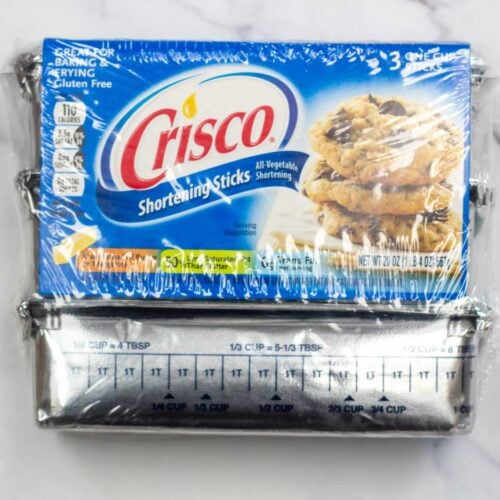Introducing a fascinating kitchen curiosity: 1/2 cup of shortening equals how much butter? Discover the secret conversion behind this common cooking dilemma. Unveil the answer and learn how to effortlessly substitute one for the other in your recipes. Let's unlock this culinary mystery together! Stay tuned for more intriguing curiosities on Curiosify.
- Unraveling the Mystery: How does 1/2 cup of shortening compare to butter?
- What is the amount of butter equivalent to 1/2 cup of Crisco?
- Is a half cup of butter equivalent to a half cup of shortening?
- How much butter can be used as a substitute for shortening?
- What can I substitute for 1/2 shortening?
-
Preguntas Frecuentes
- How does the measurement of 1/2 cup of shortening compare to the equivalent amount of butter?
- Is there a direct conversion between 1/2 cup of shortening and butter, or are there other factors to consider?
- Are there any differences in taste or texture when using 1/2 cup of shortening versus the same amount of butter in recipes?
Unraveling the Mystery: How does 1/2 cup of shortening compare to butter?
When it comes to baking, the choice between shortening and butter can sometimes be perplexing. Understanding how these ingredients compare in terms of measurements can help unravel the mystery.
Typically, a 1/2 cup of shortening can be substituted with an equal amount of butter. However, it's important to note that the two differ in texture and composition, which can affect the final outcome of your baked goods.
Shortening, usually made from hydrogenated vegetable oils, is solid at room temperature and has a high melting point. This property helps create tender and flaky pastries. On the other hand, butter contains dairy fat and has a lower melting point. Its creamy texture and flavorful taste make it a popular choice for many bakers.
When substituting one for the other, consider the impact on texture and flavor. Since butter contains water, it might alter the moisture content of the recipe, potentially resulting in a different texture. Shortening, being mostly fat, is often used to achieve a specific texture, such as in pie crusts or cookies that need to hold their shape better.
Experimenting with both ingredients in your recipes will allow you to discover the nuances each one brings to your baked goods. Whether you choose to stick with traditional shortening or opt for the richness of butter, understanding the differences between the two will help you create delicious treats every time.
What is the amount of butter equivalent to 1/2 cup of Crisco?
Did you know that 1/2 cup of Crisco can be replaced with approximately 113 grams or 1 stick (1/2 cup) of unsalted butter? It's always good to have alternatives when cooking or baking, especially if you want to incorporate different flavors or textures into your recipe. So, next time you're in the kitchen and find yourself short on Crisco, don't worry, just reach for some butter instead!
Is a half cup of butter equivalent to a half cup of shortening?
No, a half cup of butter is not equivalent to a half cup of shortening. While both butter and shortening can be used in baking, they have different properties and will affect the final results of your recipe. Butter adds flavor and richness to baked goods due to its milk fat content, while shortening provides a neutral taste and creates a tender texture. Therefore, substituting one for the other may alter the taste and texture of your recipe. It's best to follow the specific instructions in your recipe to ensure the desired outcome.
How much butter can be used as a substitute for shortening?
Butter can be used as a substitute for shortening in a 1:1 ratio. This means that if a recipe calls for 1 cup of shortening, you can use 1 cup of butter instead. However, it's important to note that butter has a lower melting point than shortening, so it may affect the texture and flavor of the final baked goods. Additionally, butter contains water, whereas shortening is 100% fat, so using butter may result in slightly different results.
What can I substitute for 1/2 shortening?
If you're looking to substitute 1/2 cup of shortening in a recipe, there are a few alternatives you can use. One option is to use an equal amount of butter. Another option is to use an equal amount of coconut oil. Both butter and coconut oil will add moisture and richness to your baked goods. Just keep in mind that using butter may result in a slightly different flavor compared to shortening.
Preguntas Frecuentes
How does the measurement of 1/2 cup of shortening compare to the equivalent amount of butter?
In terms of comparison, 1/2 cup of shortening can be substituted with an equivalent amount of butter. However, it is important to note that the texture and taste of the final product may differ slightly due to the differences in fat content and composition between the two. Shortening is a solid fat made from vegetable oil, while butter is a dairy product consisting of milkfat. Butter contains water and milk solids, which contribute to its distinct flavor and creaminess. When substituting butter for shortening, it is recommended to use an equal amount by volume, but be aware that the final result may have a richer taste and softer texture.
Is there a direct conversion between 1/2 cup of shortening and butter, or are there other factors to consider?
Are there any factors to consider when converting 1/2 cup of shortening to butter?
Yes, there are a few factors to consider when converting measurements from shortening to butter. While you can generally substitute butter for shortening in a 1:1 ratio, there are a couple of things to keep in mind:
1. Consistency: Shortening has a higher fat content and a different consistency compared to butter. This means that when using butter as a substitute, the texture of the final product may be slightly different. For example, cookies made with butter tend to spread more than those made with shortening.
2. Flavor: Butter has a distinct flavor that can enhance the taste of baked goods. However, this can also depend on personal preference. If you enjoy the taste of butter, using it as a substitute can add a rich, buttery flavor to your recipe.
3. Melting point: Butter has a lower melting point compared to shortening. This can affect the texture and structure of your baked goods. To compensate for this, you may need to adjust the baking temperature or chilling time.
In conclusion, while you can generally substitute butter for shortening in a 1:1 ratio, the final result may have a slightly different texture and flavor. Adjustments to baking temperature and chilling time may also be required.
Are there any differences in taste or texture when using 1/2 cup of shortening versus the same amount of butter in recipes?
Yes, there are differences in both taste and texture when using shortening versus butter in recipes.
In terms of taste, shortening has a milder flavor compared to butter. It typically lacks the creamy and rich taste that butter provides. This can be beneficial in certain recipes where you don't want the butter flavor to overpower other ingredients.
In terms of texture, shortening tends to create a softer and more tender end product. It has a higher melting point than butter, which means that it takes longer to melt during baking. This can result in a more tender and delicate texture in baked goods, such as cookies or pie crusts. Shortening can also lend a lighter and flakier texture to pastries.
On the other hand, butter contributes to a richer and more flavorful taste in baked goods. It has a lower melting point, which allows it to spread and coat the ingredients more evenly. Butter also contains water and milk solids, which can add moisture and richness to baked goods. As a result, using butter can lead to a slightly denser and chewier texture in some recipes.
When substituting shortening for butter, it's important to keep in mind these differences in taste and texture. The choice between the two depends on the desired outcome of the recipe and personal preference.
In conclusion, we have delved into the curious world of cooking substitutes and discovered an interesting correlation between shortening and butter. Through our exploration, we have determined that 1/2 cup of shortening can be equivalently replaced with 1/2 cup of butter. This revelation offers a unique insight for bakers and cooks looking to experiment with different ingredients in their recipes. Whether you choose to use shortening or butter, remember to consider the impact it may have on taste, texture, and overall results. Keep on exploring the quirks of the culinary world, where even the smallest substitutions can yield fascinating outcomes. Happy cooking!
Si quieres conocer otros artículos parecidos a The Equivalence Mystery: How Much Butter Does 1/2 Cup of Shortening Actually Equal? puedes visitar la categoría Home.

